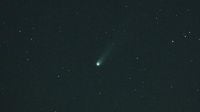Stargazers and night owls across the globe have a thrilling week ahead, with the cosmos providing a dazzling spectacle of celestial events as October 2025 winds down. From the waxing crescent moon’s subtle glow to the rare passage of Comet Lemmon and the autumnal return of Fomalhaut, the night sky is brimming with wonders. And as Halloween approaches, a powerful full moon aligns with the sacred Sabbat of Samhain, promising a night steeped in both astronomical brilliance and mystical tradition.
As reported by Mashable, the moon on October 25, 2025, is in its Waxing Crescent phase, with 14% of its surface illuminated. For those who have endured several nights with little lunar visibility, tonight marks a welcome return of the moon’s familiar features. Without any visual aids, keen observers can spot the Mare Crisium and the Mare Fecunditatis—two vast, dark plains etched into the moon’s surface. If you have binoculars or a telescope handy, the Endymion Crater will also come into view, adding depth and intrigue to the moon’s face.
“After nights of too little visibility, the moon is finally big enough to see some features on its surface,” Mashable notes. For those in the Northern Hemisphere, these features will appear on the right side of the moon, while in the Southern Hemisphere, they’ll be visible on the left. This shifting perspective is a direct result of the moon’s 29.5-day orbital cycle, a dance governed by the ever-changing angles between the Sun, Moon, and Earth. As NASA explains, these angles determine how much of the moon’s surface is lit up, giving rise to the familiar progression of phases: from New Moon to Waxing Crescent, First Quarter, Waxing Gibbous, Full Moon, Waning Gibbous, Third Quarter, and finally Waning Crescent.
The next full moon, according to NASA’s Daily Moon Observation, will grace the sky on November 5, 2025. But before that, the lunar show will be upstaged by a rare and mystical convergence on Halloween night.
This year, October 31 brings more than costumes and candy. As detailed in a recent guide to cosmic witchcraft, the Full Moon will coincide with Samhain, the ancient Celtic festival marking the end of the harvest season and the beginning of winter. This sacred Sabbat is believed to be the time when the veil between worlds is thinnest, allowing for clearer communication with ancestors and spirit guides. When this potent spiritual energy merges with the Full Moon’s radiant illumination, it creates what some call a “supercharged portal for manifestation.”
“This is not just a night for costumes and candy; it is a potent cosmic ceremony waiting for you to participate,” the guide proclaims. The alignment is seen as the ultimate opportunity for powerful witchcraft and intention-setting, with practitioners encouraged to harness the combined energies for love, wealth, and personal power.
Three focused spells are outlined for those wishing to tap into the Halloween Full Moon’s energy. The Crimson Cord Love & Reconciliation Spell Jar calls for a red or pink candle, rose petals, cinnamon, pins or thorns, honey, and a red pen, all sealed in a jar and bathed in moonlight to attract or heal love. The Golden Coin Wealth & Abundance Spell Jar uses a green or gold candle, coins, citrine or pyrite, bay leaf, alfalfa or basil, and a green pen, with the aim of opening financial pathways and inviting prosperity. Finally, the Obsidian Mirror Power & Protection Spell employs a black candle, a small mirror, obsidian or black tourmaline, dragon’s blood incense, and carrier oil to reclaim personal power and ward off negativity. Each ritual is designed to be performed on the night of October 31, when the Full Moon’s energy is at its peak.
While the moon and magic capture the imagination, the night sky’s wonders don’t end there. On October 26, 2025, Comet Lemmon (C/2025 A6) makes a dramatic appearance, slicing through the stars of the constellation Serpens Caput. According to Space.com, Comet Lemmon was discovered earlier that year on January 3 and has been brightening steadily as it approaches the sun. By late October, its magnitude is estimated at +4.3, making it visible to the naked eye from dark-sky locations—a rare treat for comet enthusiasts and casual observers alike.
To catch a glimpse of this ancient visitor, look to the western horizon at sunset on October 26. The comet’s hazy glow will shine directly beneath the triangle of stars marking the head of the great serpent in Serpens Caput. By the following night, Comet Lemmon will have moved through the serpent’s neck, heading toward the constellation Ophiuchus, the “snake bearer.” As Space.com explains, Serpens is unique in that it appears in two halves in the night sky: Serpens Caput (the head) and Serpens Cauda (the tail), separated by Ophiuchus. While the comet is technically bright enough to spot with the unaided eye, binoculars or a telescope will reveal its tail and gaseous shell in greater detail, enhancing the viewing experience.
As if a waxing moon, a mystical full moon, and a comet weren’t enough, the autumn sky offers yet another gem: the return of Fomalhaut, the “lonely star” of fall. Fomalhaut, situated in the faint constellation Piscis Austrinus (the Southern Fish), becomes visible in the southern sky from late October through November, shining with a pale white or blue light. Fomalhaut is about 25 light-years from Earth and is approximately 16 times as luminous as our Sun, making it a beacon for both seasoned astronomers and curious newcomers.
According to astronomers cited by Space.com, Fomalhaut is best spotted between 8 p.m. and 10 p.m. on clear autumn evenings. In the Northern Hemisphere, it hovers low on the southern horizon, while in the Southern Hemisphere, it climbs much higher in the sky. The star’s solitary brilliance makes it easy to find, even in areas with moderate light pollution. Beyond its visual allure, Fomalhaut is scientifically fascinating; it’s surrounded by a vast ring of dust and debris, possibly the early stages of a planet-forming system. In 2008, NASA’s Hubble Space Telescope captured an image of what was thought to be a planet orbiting Fomalhaut—a discovery that sparked excitement, though later observations suggested it could be a cloud of dust from colliding objects. Regardless, Fomalhaut’s annual return serves as a celestial marker, signaling the transition from summer’s warmth to winter’s chill.
For those eager to make the most of these astronomical events, a few tips go a long way. Find a dark spot away from city lights, allow your eyes time to adjust, and bring binoculars or a telescope for enhanced views. Whether you’re marveling at the moon’s craters, tracing a comet’s journey, or spotting Fomalhaut’s steady glow, October’s night sky offers something for everyone—science buffs, spiritual seekers, and casual skywatchers alike.
As the month draws to a close, the universe seems intent on reminding us of its beauty and mystery. With every phase of the moon, every streaking comet, and every solitary star, the heavens invite us to look up, reflect, and perhaps even make a little magic of our own.





